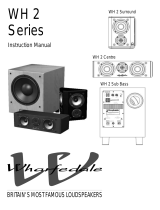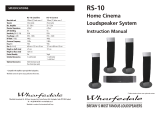Page is loading ...

The name ‘WHARFEDALE' is a registered trademark of Wharfedale International Limited.
Wharfedale has a policy of continuous product development and reserves the right to change
specification without notice.
Wharfedale is a member of the International Audio Group.
1932
In 1932, when Gilbert Briggs founded the Wharfedale Wireless Works, his company was at the
leading edge of an exciting new technology which was dedicated to bringing the pleasure of
music and entertainment to a wide range of people. As the technology advanced Wharfedale
gave many music lovers their first taste of High Fidelity, mounting a series of live sound
demonstrations which excited the audio world and heralded the era of the modern hi-fi
loudspeaker.
Today Wharfedale still takes the same uncompromising approach to the design and manufacture
of every loudspeaker system, using high quality components and state-of-the-art testing to
ensure consistently high performance. And that means that you can continue to count on the
quality of all Wharfedale products.
Loudspeaker Manufacturers since 1932
Specifications and Service
Dimensions Overall
HxWxDmm
HxWxDinches
Nominal Impedance
Recommended Amplifier Power
Sensitivity (1W@1m)
Frequency Response
Bass Unit
Midrange Unit
Wharfedale Crystal speakers are compatible with most currently available audio amplifiers
Authorised Wharfedale Service Centres
For information on other authorised service centres worldwide contact
Wharfedale International in the U.K.
A worldwide distributor list is available on the Wharfedale website:
www.wharfedale.co.uk
Treble Unit
220 x 180 x 155
8.7 x 7.1 x 6.1
4 Ohms
25-60 Watts
84 dB
75-20kHz
101 mm
Crystal
CR 8
25mm Textile
295 x 210 x 225
11.6 x 8.3 x 8.9
4 Ohms
25 -100 Watts
86 dB
55-20kHz
170 mm
Crystal
CR 10
25mm Textile
330 x 235 x 225
13.0 x 9.3 x 8.9
4 Ohms
25 -100 Watts
86 dB
45-20kHz
170 mm
Crystal
CR 20
25mm Textile
850 x 235 x 225
33.5 x 9.3 x 8.9
4 Ohms
25 -100 Watts
87 dB
40-20kHz
170 mm
Crystal
CR 30
25mm Textile
1000 x 235 x 225
39.4 x 9.3 x 8.9
4 Ohms
30 -150 Watts
88 dB
30-20kHz
170 mm
170 mm Bass-Mid
Crystal
CR 40
25mm Textile
167 x 380 x 155
6.6 x 15.0 x 6.1
4 Ohms
25 - 100 Watts
86 dB
60-20kHz
2 x 101 mm
Crystal
CR CEN
25mm Textile
USA
IAG America, Inc.
15 Walpole Park South
Walpole
MA 02081
Tel: +1 508 850 3950
CANADA
Korbon Trading Ltd
6800 Kitimat Road
Units 19-20
Mississauga
Ontario
Tel: +1 905 567 1920
UK
Wharfedale International Ltd.
IAG House, Sovereign Court,
Ermine Business Park,
Huntingdon,
Cambs PE29 6XU,
England.
Tel:+44 (0)1480 447700
Fax: +44 (0)1480 43176
Crystal
Series
Instruction Manual
BRITAIN'S MOST FAMOUS LOUDSPEAKERS
If your system appears not to be working as well as you expect, the following notes may be
ofsomehelp.
Beforeinvestigatingthecauseof a problem,always switch offthe system atthe mains.
Please bear in mind that Home Theatre systems can be quite complex and there is often a
varietyof factors involved.
Pleaseread this manualtogether with allthe manuals concerningthe rest ofyour system.
If,having attempted to resolve the problem, the trouble still persists, consult your dealer for
assistance.
Do NOT try to remove any covers on the product or attempt to dismantle it in any way. There
areno user serviceableparts inside andyou will invalidateany warranty.
Television picture is distorted or there is colour distortion
Excessive bass distortion at low volume levels
Excessive or distorted bass at high volume levels
Popping sounds or thumps from Front speakers or subwoofer
Indistinct sound
Poor localisation of effects
Distorted or rattling sounds at high volume levels
Sound lacks bass content
Bass reproduction muddy or indistinct
No Sound
Symptom
Front loudspeakers or subwoofer too close to the TV. (Switch off the system and TV. Move loudspeaker
away. Leave 15 mins. Switch on again)
Bass level set too high
LFE level set too high
System level set too high
Front loudspeakers or subwoofer too close to room corners
System level set too high
LFE level set too high: Subwoofer level set too high
One or more loudspeakers is out of phase
(See the relevant pages of this manual for the correct connection procedure)
System level set too high
Objects placed on Front loudspeakers or subwoofer
Loudspeakers wired incorrectly
Front speakers set to ‘Small’ with no subwoofer connected
System not switched on
Wrong source selected
Possible Cause
Further help and advice
A wide range of AV and audio topics can be found at the Wharfedale web site.
Home Theatre is discussed in depth at the Dolby Laboratories web site.
The Digital Theater Systems web site is also full of interest and worth a visit.
www.wharfedale.co.uk
www.dolby.com
www.dtsonline.com
Troubleshooting

ConnectingYour Loudspeakers-Bi-Wiring
Bi-Amplifying (Bi-Amping)
CentreChannel andSurround Connections
ConventionalLoudspeakers
CRCEN Centre Loudspeaker
Note:
Using separate cables for treble and bass units in a Bi-Wiring configuration reduces intermodulation
effects and improves headroom and clarity. To bi-wire, you willneed to install two lengths of twin core
cablebetween the amplifierand each loudspeaker.
Unscrew each terminal a few turns and remove the metal straps. Connect the cables between the
amplifierand the loudspeakersas indicated aboveand re-tighten allthe terminals securely.
Some amplifiers have two pairs of output terminals to facilitate bi-wiring but this is not
essential. The advantages of bi-wiring are fully retained if your amplifier has only one pair of output
terminalsper channel (asin the illustration).
By connecting each loudspeaker drive unit to its own dedicated amplifier the advantages of Bi-Wiring
can be extended. If you own two identical stereo power amplifiers, your Crystal speakers may be Bi-
Amped.For further detailsplease consult yourdealer
The CR CEN and rear surround loudspeakers are intended for use specifically with Audio Visual
equipment having Centre and Rear loudspeaker outputs. Connect these loudspeakers as shown,again
observingpolarity. The speakersmay be connectedas shown, orbi-wired.
Models CR 30 and 40 are designed to be floor standing. We suggest that they are positioned at least
200 mm from the rear walls and 700 mm from the side walls, facing slightly inwards. Models CR 8, 10
and 20 should ideally be stand or wall mounted though they may be placed on a rigid shelf. The bass
extension will improve if these speakers are operated closer to the rear walls. A useful rule of thumb is
thatthe listener shouldbe as farfrom the loudspeakersas they arefrom each other.
If the loudspeakers are placed too close to the walls the bass will increase but may be boomy and
indistinct. If the loudspeakers are placed further away from the walls, the inward angle may be
increased by up to 40%, although this may restrict the width of the optimum listening position. The
speakers should ideally be positioned so that the treble units are roughly at ear level to a seated
listener. As personal taste plays a large role, experiment with different configurations and play a wide
rangeof programmes beforefinalising the positionof your speakers.
The loudspeaker should be positioned centrally between the loudspeakers close to the television and
mountedeither above orbelow the screen.
The loudspeaker should be located on a stable flat surface to avoid any danger of the cabinet moving
when it is vibrated by high sound levels.If you mount the unit on top of the television, move it forward
so that the front grilles are level with or slightly in front of the screen. This will reduce reflections from
thescreen and thetop of thecabinet.
Although you can place the centre channel
loudspeaker under the TV monitor, this should always
be regarded as second best. The preferred position is
alwaysabove the monitor,as shown.
The CR CEN uses screened drive units and may be
placedclose to aTV screen withoutill-effects.
Conventional loudspeakers should not be operated
within 500mm of a TV screen as the drive unit
magnets may interfere with the picture and cause
colourdistortion.
PositioningYourLourspeakers
.
Unpackingthe Speakers
Fittingthe Plinthand Spikes (CR 30, CR40)
Standsand Brackets
CRCEN Centre ChannelLoudspeaker
Choosingand PreparingCables
CrossoverNetworks
ConnectingLoudspeakerTerminals
ConnectingYour Loudspeakers-Standard Connections
Carefully remove each loudspeaker from its packing carton. Be especially careful when removing the
polythenebag.
DONOT attempt tolift the loudspeakerby the polythenebag.
Retainthe packing forfuture use. Ifyou decide todispose of thepacking, please doso safely.
Carefully invert each loudspeaker. Protect the top surface
from scratches or damage when the loudspeaker is inthe
invertedposition.
Each loudspeaker has four spikes. Prepare the
spikes as shownandscrew them into the threads
on the base of the loudspeaker. Return the
loudspeaker to its normal position taking care
not to cause damage with the spikes. When
moving speakers, be careful not to let the spikes
pierce objects or cables which may be concealed
under the carpet. Never drag loudspeakers. If youcannot
liftthem easily, getsomeone to assistyou.
The CR 8, 10 and 20 are intended primarily for stand mounting, though they can be mounted on wall
brackets or even on sturdy shelves. The quality of loudspeaker stands makes a considerable difference
tothe performance ofyour loudspeakers sodo not useflimsy inferior products.
Asetof self adhesivepadsis provided. Peeloff the backing materialand fix a padclose to each cornerof
thebottom surface ofthe loudspeaker.
Specialist audio cable usually offers better performance than general
purpose'bell' or 'zip'wire.
Choose a cable of suitable diameter - cable that is too thin will limit the
dynamics of the sound and may impair the bass response. Audio cable is
polarised, withtwocores of different colours, or often a raisedribor coloured
tracerin the caseof twin cable.
Split the twin cores to a depth of about 40mm. Carefully strip the insulation
from each end, leaving about 10mm of bare wire. If the cable is stranded,
lightlytwist to gatherany loose strands.
Crystal loudspeakers use a specially designed bi-wireable
crossover panel with four terminal binding posts. Please
follow the drawing carefully to see the correct orientation
of the loudspeaker terminals. The upper terminals connect
to the treble unit, the lower pair to the bass unit. As
supplied, the treble terminal pair is connected to the bass
terminal pair via removable metal straps.These should be
leftin place forstandard installations.
Unscrew the terminal. Thread the bared end of each cable through the hole in the bottom of the
terminal post. Ensure that there are no loose strands which may touch adjacent terminals. Retighten
theterminal securely. Thedrawing above illustratesthe method.
: When connecting loudspeakers, the cables to left and right channels should be of equal length,
regardlessof the distanceof the speakersfrom the amplifier.This applies tofront and rearchannels.
Chooseasuitable length oftwin core speaker cablefor each channel,andprepare the endsas described
above.Unscrew each terminala few turnsbut leave thestraps in place.
Connect the red, positive (+) terminal of the Left loudspeaker to the corresponding red, positive (+)
amplifier terminal. Connect the black, negative (-) terminals similarly. Tighten the terminals securely.
Repeatthis procedure forthe Right Channel.
NOTE
Wharfedale Crystal Series Installation and User Guide
Introduction
The WharfedaleCrystal Seriesis a range of versatile loudspeakersusingadvanced materials and the latest
precision drive units. The CR10 and 20 are small stand mounting loudspeakers. The CR30 and 40 are
floor-standing models. The range includes a centre channel, CR CEN. The CR8 may be used as either
surround sound speakers in Home Theatre applications, or as the main speakers in a small stereo system.
Tocomplement yoursystem, choosefrom ourrangeof Powercubepowered subwoofersfor theperfect Home
Cinema experience. Thank you for purchasing Wharfedale. We hope your loudspeakers will give you a
rewardinglistening experienceformanyyears.
Before making connections to any part of your sound system make sure the amplifier and all connected
sourcesareswitchedoff.
When you switchonyour system or change sources, set the volume control to minimumandturn up the
level gradually.
DO NOT use your amplifier at full volume. The position of the Volume Control is NOT a reliable
guide as to the maximum volume level or capabilities of your sound system. Playing the system with
extreme high settings of volume and tone controls will result in distorted sound and may damage the
amplifierand loudspeakers.
DONOT connect loudspeakerterminals to themains supply.
Ensurethat all loudspeakersin the systemare correctly wiredand are inphase.
DONOT subject yourloudspeakers to excessivecold, heat, humidityor sunlight.
WARNING: To reduce the risk of fire or electrical shock do not expose this product to rain or moisture.
The product must not be exposed to dripping and splashing and no object filled with liquids such as a
vaseof flowers shouldbe placed onthe product.
Nonaked flame sources- such ascandles - mustbe placed onthe product.
DONOT place heavyobjects on topof loudspeaker cabinets.
NEVERlet anyone, especiallychildren push anythinginto holes, slotsor other openingin thecase.
If you wish to play yourloudspeakerswiththeir
grillesremoved be carefulto protect thedrive units fromchildren and pets.
DO NOT use makeshiftstands.Always fit a manufacturer's approved stand according to the instructions
andusing the fixingsprovided. Yourdealer willadviseyou.
Pleasereadtheseinstructionscarefully beforeinstalling your Wharfedaleloudspeakers.
NEVER touch the drive units whichareeasilydamaged.
Preparing and Connecting Your Loudspeakers
LEFTRIGHT
Links between
Treble & Bass
terminals
removed
Bass
Treble
FRONT
LEFT
FRONT
RIGHT
TheHomeTheatre Environment
CareandMaintenance
Frontand EffectsChannels
SettingLoudspeakerSizes
SettingLevels
DelaySettings
LFE
Phase
HidingCables
RunningIn
Guarantee& Service
Conclusion
Manydigital AV Processorsrequireyouto specifythesize ofspeakersin allchannels.
Always choose 'Small' for the Surround channels and Centre channel whether you are using a
subwooferor not.
Set the Front Speakers to ‘Large’. Set the ‘Subwoofer’ option on
theprocessor to 'Off'or ‘No'. TheFront channels willnow receive allthe system bass.
: When set to ‘Small’ all the system bass will go into the subwoofer. If
you choose ‘Large’ the Front channel bass will be reproduced from the Front speakers. Bookshelf
speakersshould be setto ‘Small’, largefloor standing units may besetto ‘Large’.
Once the loudspeaker settings have been finalised, put the AV amplifier into its “Test” mode (see
instructions supplied with your processor). Adjust the level of each channel in turn until all channels
arereproduced at equalloudness.
On some programme material the surround channel may seem lower than the front. Do not readjust
this level. You may, however, need to adjust the subwoofer output level. Avoid setting too high a level
or you will swamp the sound with bass which be tiring to listen to and may limit the subwoofer’s ability
to respond to large bass transients. You should also set a sensible level going into the subwoofer from
theAV processor.
Many AV processors feature delay settings to enable surround anddialogueinformationtoarrive at the
listener’s ears at the same time as the Front channels, even when the listening seat is in a non-ideal
position.
If the listening position is equidistant from the Front and Rear speakers, set a low delay
setting.The closer thelistener is tothe Rear speakersthe higher shouldbe the delaysetting used.
If the Centre speaker is level with (or slightly behind) the Front speakers, set the delay
tozero. If theCentre speaker isforward of theFront speakers, increasethe delay.
In the cinema the Low Frequency Effects channel is an extra bass channel with its own subwoofer and
not a regular subwoofer channel. In domestic systems the LFE channel typically feeds into the
subwoofer. Where no subwoofer is used, the LFE signal is combined with Front Channel information.
When you set the LFE level at your AV processor, use care as the powerful low frequencies can overload
domesticloudspeakers.
Ifyouhear popping or thumpingnoisescoming from the front loudspeakersor subwoofer, immediately
turnthe AV Processor'svolume leveldown and thenbackoff the LFElevel. This shouldcure the problem.
If it does not, back off the volume level at the subwoofer (if you are using one) until the problem
disappears.
Please read the relevant sections of your AV amplifier manual and familiarise yourself with the various
issues.If you areunsure, consult yourdealer for help.
A Home Theatre systemshould have a precise front stage, a diffuse rear stage and good localisation of
dialogue.Ifthe colours on the loudspeakerterminalsdo not correspond with thoseon the amplifier, the
sound will appear poorly focussed or ‘outof phase’. For this reason it is essential that the speakers are
connectedaccording to thewiring diagrams inthis manua
When mounting a loudspeaker on a wall the connecting cables may be unacceptably obvious. Whilst
cables can be routed from the loudspeaker to the floor, it may be less obtrusive to route cables from the
loudspeaker to the ceiling and then within the ceiling (or possibly coving) or immediately underneath
theceiling (or coving).The cable maythen return tofloor level ata convenientroomcorner.
The loudspeaker cabinets can be cleaned with a damp cloth or with a spray furniture polish and a soft
cloth. Apply the spray sparingly to the cloth and then polish the cabinet. Never apply spray directly to
thecabinet. Grilles shouldbe removed andgently brushed witha soft brush.
Inthe unlikely eventthat your unitdevelopsa faultyou should returnitto yourWharfedaledealer using
theoriginal packing toensure safe shipping.
Theterms of yourguarantee may varyin different countriesbut in allcases the guaranteeexcludes:
Alldamagecaused through accident,misuse, wear and tear,neglect, incorrect installation,adjustment
orrepair by unauthorisedpersonnel.
Liabilityfor damage orloss occurring intransit to orfrom the purchaser.
Wharfedale will not be liable for any consequential damage, loss or injury, arising from or in
conjunctionwith this equipment.
The Crystal series is just one of an extensive and world-acclaimed range from Wharfedale, one of the
world’s oldest and most distinguished loudspeaker manufacturers. Thank you for purchasing
Wharfedale;we hope thisproduct brings youmany years ofreliable service andgood music.
If you are not using a subwoofer:
If you are using a subwoofer
Rear Delay:
Centre Delay:
l.
Cleaning
The front loudspeakers are placed on either side of the television screen, 2 to 3 metres apart. The
speakersshould be angledslightly so theyare aimed towardsthe listeners.
As the rear surround channels are the ‘effects’ channels the reproduced sound should be as room filling
as possible. We recommend placing the speakers in a high position, behind the listener’s head and
angled towards the listener. If the rear wall is more than 1metre behind the listening seat, position the
unitson the sidewalls. If thewalls are along way fromthe listening seat,consider standmounting.
Most of the dialogue comes from the centre loudspeaker. Speech should appear to originate from the
actors’ mouths. Operating height is important. Ideally the front and centre channel speakers should be
atthe same height.For this reasonthe centre channelspeaker is bestoperated on topof the TVmonitor.
Thefront faces ofthe centre andsurround loudspeakers shouldalso be inline as faras possible.
As the ear is unable to detect the direction from which deep bass originates, this allows you freedom to
position the unit. Varying the distance from the wall alters the bass. Placing the subwoofer across a
cornerboosts the bassbut may impairclarity.
Theperformance of HomeTheatre systems canoften be enhancedby using apair of subwoofers.
Loudspeakersareelectro-mechanical and, like allmechanicalsystems, they need a'running in' period.
For the first 50 hours or so exercise care and play your system at reasonable volume levels. After
runningin, you willnotice a significantsonic improvement.
Subwoofer
REAR
RIGHT
REAR
LEFT
FRONT
LEFT
FRONT
RIGHT
CENTRE
ALTERNATIVE
POSITIONS
ALTERNATIVE
POSITIONS
SUB
BASS
UNIT
CENTRE
FRONT
REAR
LEFTLEFT RIGHTRIGHT
SUB
WOOFER
REAR
RIGHT
REAR
LEFT
CENTRE
LEFTRIGHT
FRONT
LEFT
FRONT
RIGHT
2 - 4 metres
>0.7metre
CR 30 CR 40
>200 mm
CR 8,10,20
>50 mm
1
5
-
4
0
º
VIDEO/DVD
RACK
TV
Caution - Connecting Wires
When connecting your loudspeakers,
avoid trailing cables across open floor
spaces where they can be a source of
danger.
Route cables safely under carpets or
alongroom boundaries.
/




